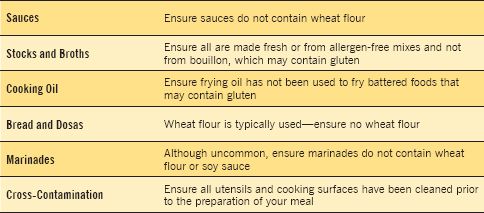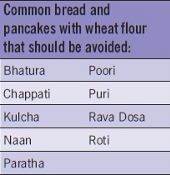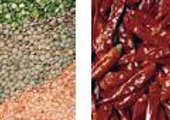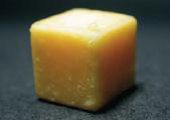
Although gluten is present in some areas of Indian cuisine, we have outlined 25-plus items in our sample menu. There are six primary points that you need to consider when dining at an Indian restaurant. To ensure a gluten-free experience, the areas of food preparation that you need to inquire about with your server or chef are listed below.

Sauces
Culinary practices vary in Indian restaurants. Although it is uncommon, some sauces may have wheat flour added to them as a thickening agent. Many standard Indian condiments such chutney, Indian pickles or raita resemble sauces. Chutneys are spicy fruit or vegetable spreads and are very common in Indian restaurants. Indian pickles are made with fruit or vegetables in oil with aromatic spices and differ from western pickles in that they resemble relish. They almost never contain vinegar and are not made from cucumbers. Raita is a yogurt dipping sauce.
Although ingredients will vary widely from restaurant to restaurant, below is a list of common and typically gluten-free condiments and their ingredients.
Coconut Chutney — Coconut, chili pepper, vegetable oil, yogurt, Indian herbs and spices
Mango Chutney — Mango, ginger, onions, raisins, Indian herbs and spices
Mint Chutney — Mint, chili pepper, lemon juice, onions, salt, sugar, oil, Indian herbs and spices
Tamarind Chutney — Tamarind pulp, sugar, oil, water, Indian herbs and spices
Tomato Chutney — Tomato, chili pepper, cilantro, garlic, salt, sugar, tamarind juice, Indian herbs and spices
Indian pickles — Any type of fruit or vegetable with Indian herbs and spices in oil
Raita — A yogurt sauce with Indian herbs and spices, which may also contain sliced onions and tomatoes
Stocks and Broths
Stocks and broths are used frequently in Indian cuisine and are present in sauces and soups. Ensure all are made fresh or from allergen-free mixes and not from bouillon, which may contain gluten.
Cooking Oil
Indians sometimes use ghee (clarified butter) to fry foods because of its perceived health benefits and high smoking point. The flavor is rather strong, so many chefs prefer to use other types of oils including: canola, coconut, corn, mustard seed, olive, peanut, sesame and sunflower. Outside of India, vegetable oil may be substituted from time to time. Oil is used to fry or sauté foods. When ordering food that is prepared by frying, ensure that there is a dedicated fryer in the kitchen for non-battered menu items. Since battered foods may contain wheat flour, this practice minimizes the potential of gluten cross-contamination from frying.
Bread and Dosas
Dosas, a South Indian version of the crepe or pancake, are usually stuffed with a filling and served with chutneys. In some cases, they resemble a pizza, with the ingredients placed on the top of the crepe or pancake. Dosas are often made with black gram, lentil, potato or rice flour. If ordered, ensure that dosas do not contain wheat flour.

With the exception of many dosas, most breads and pancakes are made with wheat flour in Indian restaurants. At left is a list of common breads and pancakes made with wheat flour that should be avoided.
Marinades
Marinades are used frequently in Indian restaurants and differ from most cuisines in that they are typically citrus or yogurt based. Although uncommon, other types of marinades may be used in restaurants that incorporate non-traditional culinary practices. If this is the case, ensure that the marinade does not include soy sauce, which contains wheat, or wheat flour.
Cross-Contamination
Cross-contamination occurs in two primary instances and should be considered at any restaurant you choose to dine in. One may occur when your meal is prepared in the same frying oil as foods containing other possible allergens. The second may occur when food particles are transferred from one food to another by using the same knife, cutting board, pots, pans or other utensils without washing the surfaces or tools in between uses. In the case of open flamed grills, the extreme temperature turns most food particles into carbon. Use of a wire brush designed for grill racks typically removes residual contaminants. To avoid cross-contamination, restaurants need to dedicate fryers for specific foods and wash all materials that may come in contact with food in hot, soapy water prior to preparing items for those with special dietary requirements. It is important to ensure that the restaurant follows these procedures for an allergen-free dining experience.
If you have food allergies or sensitivities, it is important to remain diligent in your approach to dining out. Because Indian cuisine is complex, there are many common food allergens used on a regular basis. While in India, be aware that ghee (clarified butter) is often used to fry foods. Know that vegetable oil can always be substituted for any oil and may contain corn, peanuts or soy. Peanuts and tree nuts are frequently used both as an ingredient and in cooking oils. If used, bouillon may contain Hydrolyzed Vegetable Protein (HVP) that can be derived from corn, soy or wheat. We have indicated the potential presence of bouillon and cooking oils.
For each item listed in the sample menu, we have identified where gluten and wheat are typically included in the dish as an ingredient. We have also indicated where gluten and wheat may be present based upon non-traditional culinary practices. The chances of encountering these in our sample menu are outlined below.
Moderate likelihood — Gluten and wheat
In addition, your sensitivity to spice levels can be an important concern. Indian food is often extremely spicy due to the use of chili peppers and powders. Tandoor dishes tend to be far less spicy than curries. In most cases, you can order dishes mild. Keep in mind that mild to an Indian chef may still be quite spicy. If you are especially sensitive, it is important to discuss these concerns with your server or chef.
Like many cuisines in Asia, Indian culinary ingredients are directly related to the availability of products in each region. Since the country is so large, there is a cornucopia of food products used in the many schools of Indian cooking. Dairy products, legumes, spices and vegetables are regularly consumed at most Indian meals. Breads, crepes and pancakes made from chickpea, lentil, potato, rice and wheat flours are also a daily staple of their diet.

Since the number of vegetarians in India is substantial, there is obviously an extensive variety of vegetables used regularly. Cabbage, carrots, cauliflower, corn, onions, potatoes, pumpkin, shallots, spinach, tomatoes and turnips are common vegetables found across Indian cuisine. Legumes such as black gram, chick peas and lentils are often used as ingredients, as well as ground into flours for bread. Nuts play a big part, with almonds, cashews, peanuts, pistachios and walnuts frequently incorporated into dishes. In addition, Indian cuisine utilizes many different types of fruit such as coconut, mango and raisins as ingredients in their dishes and in chutney, the famous spiced fruit spread.
Masala (spice) is used in the majority of dishes. Although the exact spices for a specific dish vary from chef to chef, their choices for what spices to include are standard across Indian cuisine. These common Indian herbs and spices include bay leaves, black pepper, cardamom, chili pepper, cinnamon, cloves, coriander, cumin, fennel, fenugreek, garlic, ginger, mustard seed and turmeric.
Because the cow is sacred to Hindus, dairy products are prevalent far more often than beef in Indian cooking; although, you may find beef in non-Hindu Indian restaurants. Ghee (clarified butter) is traditionally used to cook food, in addition to peanut, seed and other vegetable oils. Yogurt is often included in curry dishes, with buttermilk, cream and milk incorporated from time to time. Paneer, a soft Indian cheese, is used in vegetarian dishes and desserts.

Sources of protein in Indian restaurants are directly reflective of each restaurant owner’s religious beliefs. Generally speaking, most Indian restaurants offer chicken, fish and lamb dishes, with paneer (Indian cheese), lentils and yogurt serving as the major sources of protein for vegetarians. A Hindu restaurant would never serve beef; whereas, one would expect to find it in a Muslim restaurant, where you would not find pork or shellfish. In fact, it is rare to see pork on a typical Indian menu.
The Indian culture is known for its consumption of non-alcoholic specialty beverages. Tea is considered a national treasure, with the orange pekoe blend being the most common. Because of India’s geographic location, thousands of tea varieties are available including red, green and black. Masala Chai is a popular Indian beverage enjoyed around the world that is made with black tea, cardamom, hot milk and sugar. Another non-alcoholic specialty beverage is Lassi. It is made with yogurt and salt or sugar, which can be requested plain or with a variety of natural flavors such as mint, mango or strawberry.
Dining schedules in India vary according to religious practices. The customary eating schedule for many Hindus includes a light meal in the morning, a heavier meal in the afternoon and another light meal in the evening. For Muslims, the dining schedule is similar; however, during the month of Ramadan, fasting is observed during daylight hours.
(Bon Appetit in Hindi. It literally means “Come, let’s start eating!”)